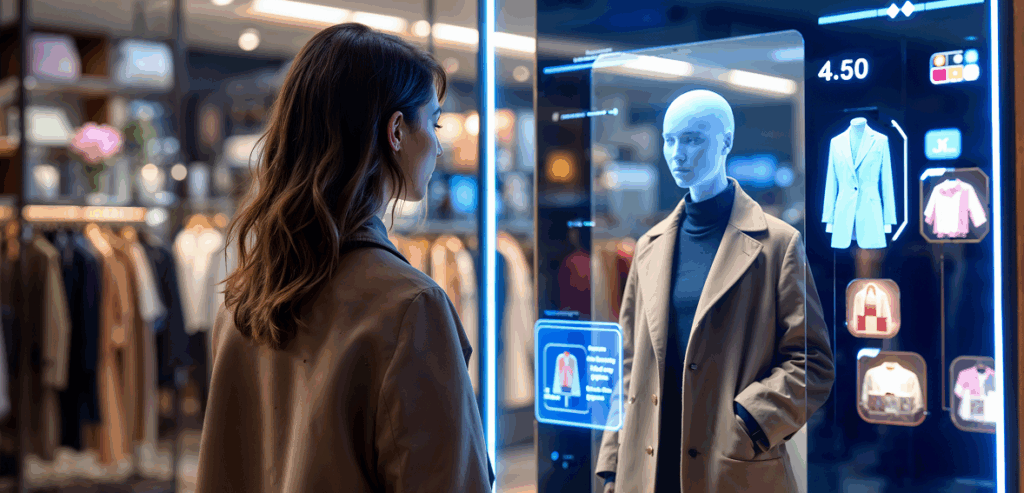
By Amelia Wall October 10, 2025
Retail and boutique businesses operate at the intersection of fashion, convenience, and customer experience. Unlike large chains that can rely on sheer volume to drive revenue, smaller retailers thrive by offering personalized service and efficient operations. Yet, even the most beautifully designed store cannot succeed if its systems for inventory, exchanges, and receipts are poorly managed. Customers today expect seamless experiences across every touchpoint, from browsing in-store to shopping online. That means retailers need to integrate technology that keeps stock accurate, simplifies returns, and offers omnichannel receipts that tie together physical and digital journeys.
The retail world has evolved significantly over the past decade. Customers no longer see a clear divide between online and offline—they shop in whichever channel is most convenient at the moment. This has placed new demands on boutiques and small retailers, who must compete not only with larger brands but also with customer expectations shaped by e-commerce giants. Getting the basics right—inventories that reflect real availability, flexible exchange policies, and digital receipts that follow the customer—creates trust and loyalty. In a crowded marketplace, these details often separate thriving retailers from those struggling to keep pace.
Why Inventory Accuracy Is the Cornerstone of Retail Success

For retail and boutique businesses, accurate inventory management is more than an operational concern—it is the backbone of customer satisfaction. When customers see a product listed online but find it unavailable in-store, frustration builds quickly. Conversely, inaccurate inventory levels in-store can lead to overselling, missed opportunities, and poor service experiences. Modern retail demands systems that provide real-time updates, ensuring that stock counts are always accurate regardless of where a sale occurs.
Inventory systems today rely heavily on integrated point-of-sale platforms that automatically adjust quantities whenever purchases or returns occur. This eliminates manual entry errors and provides managers with a clear picture of product movement. Boutiques, in particular, benefit from knowing which styles, colors, or sizes are performing best, allowing them to adapt quickly to customer preferences. Accurate inventory not only avoids disappointment but also gives businesses insight into purchasing trends, enabling smarter buying decisions. At its core, strong inventory management ensures customers always feel confident about product availability, whether shopping online or in-store.
Making Exchanges a Positive Experience
Exchanges and returns are often seen as hassles by retailers, but when handled correctly, they can be opportunities to build loyalty. Customers value flexibility and fairness, especially when investing in high-quality or boutique products. A smooth exchange process demonstrates that a retailer values customer satisfaction more than the short-term inconvenience of a returned item. Boutiques that make exchanges effortless often win repeat customers, as shoppers feel reassured that their investment is protected.
Modern systems make exchanges easier by linking transactions directly to customer profiles. Receipts—whether physical or digital—can be pulled up quickly, making it unnecessary for customers to keep paper slips. Staff equipped with easy-to-use platforms can process returns, adjust inventory, and issue exchanges in minutes. This efficiency minimizes awkward interactions and reinforces professionalism. Rather than fearing exchanges, retailers should embrace them as a chance to provide excellent service. Customers who experience stress-free exchanges are more likely to shop again, knowing that their needs will be respected no matter what.
The Rise of Omnichannel Receipts
Paper receipts are rapidly becoming a relic of the past, replaced by digital alternatives that are easier to manage, store, and access. Omnichannel receipts go a step further by ensuring that customers receive consistent documentation regardless of where they make their purchases. A shopper who buys a dress online and exchanges it in-store should have a single, unified record that tracks both transactions. This level of integration builds confidence and prevents disputes, creating a more cohesive shopping experience.
For boutiques, offering omnichannel receipts also enhances branding. Digital receipts can be customized with logos, special offers, or links to social media, extending the customer relationship beyond the checkout. They also reduce waste, aligning with sustainability goals that matter to many modern shoppers. Importantly, these receipts help retailers track purchasing behavior across multiple channels, offering insights into how customers move between online browsing and in-person visits. By adopting omnichannel receipt systems, retailers bridge the gap between physical and digital, creating seamless experiences that customers now expect as standard.
Technology as the Driver of Seamless Retail
The challenges of managing inventory, exchanges, and omnichannel receipts cannot be solved with manual systems. Technology has become the driver of efficiency and reliability in modern retail. Cloud-based POS systems, mobile applications, and AI-driven inventory forecasting tools give retailers the ability to meet customer expectations while reducing errors and inefficiencies. These systems provide real-time visibility into stock levels, automate exchange processes, and integrate digital receipts into every transaction.
For boutiques, the investment in technology can feel daunting, but the long-term benefits far outweigh the costs. Time saved through automation allows staff to focus on delivering personalized service, while accurate data ensures smarter business decisions. Technology also helps retailers adapt quickly to disruptions, such as supply chain delays or sudden shifts in demand. The future of retail lies in a balance between human connection and digital innovation, with technology acting as the bridge that keeps both elements aligned.
Enhancing the Customer Experience Through Integration
Ultimately, inventory management, exchanges, and receipts are not just back-end processes—they directly shape the customer experience. A shopper who finds the product they want in stock, feels confident in the return policy, and receives a clear digital receipt will leave with a positive impression of the brand. These small but critical interactions build the foundation of trust and loyalty. Boutiques, which rely heavily on repeat business and word-of-mouth, benefit enormously from this attention to detail.
Integration is the key to ensuring these elements work together. When inventory systems connect with exchange processes and receipt records, the result is a smooth flow of information that minimizes friction for both customers and staff. For the shopper, it feels effortless; for the retailer, it creates efficiency and consistency. As retail competition intensifies, customer experience becomes the ultimate differentiator, and businesses that master these systems are positioned to succeed in the long term.
Training Staff to Deliver Seamless Service
No matter how advanced the technology, staff play a crucial role in ensuring smooth operations. Employees must be trained not only on how to use systems but also on how to guide customers through exchanges, digital receipts, and inquiries about inventory. Confidence at the checkout or service desk reassures customers that they are in capable hands. For boutiques, where personal attention is often a selling point, staff who are comfortable with technology can blend efficiency with warmth, creating the best of both worlds.
Training should focus on real-world scenarios, from handling frustrated customers to processing exchanges quickly during peak hours. By ensuring staff can adapt easily, retailers avoid bottlenecks and mistakes that hurt customer confidence. Empowered employees also tend to deliver better service, as they feel equipped to handle challenges smoothly. Investing in training ensures that technology delivers its full potential, strengthening both operations and the human element that defines boutique shopping experiences.
Sustainability and the Shift Toward Digital Practices
In addition to efficiency, digital systems for inventory, exchanges, and receipts also support sustainability. Reducing paper receipts, cutting down on wasted stock, and minimizing unnecessary shipping or restocking all contribute to eco-friendly practices. Modern customers care deeply about sustainability, and boutiques that highlight their efforts often attract loyalty from environmentally conscious shoppers. Omnichannel receipts, in particular, eliminate the need for paper, while accurate inventory systems reduce waste caused by over-ordering or unsold products.
Retailers that incorporate sustainability into their practices not only meet customer expectations but also future-proof their businesses. Regulations and industry standards are increasingly moving toward eco-friendly requirements, and early adopters will have an advantage. By combining technology with green practices, retailers can align operational improvements with values that resonate with their audience. Sustainability, therefore, is not a separate initiative but a natural outcome of modernizing retail systems in the right way.
The Future of Inventory, Exchanges, and Receipts
Looking forward, retail technology will continue to evolve, making inventory, exchanges, and receipts even more seamless. Artificial intelligence is already helping predict customer demand and optimize stock levels. Blockchain technology could be used to track product authenticity, particularly in boutique environments where unique or high-value items are sold. Digital receipts may eventually integrate with personal finance apps, allowing customers to track spending automatically.
For retailers, staying ahead of these trends will be essential to remain competitive. Customers will continue to demand more transparency, more convenience, and more integration across channels. Businesses that view inventory, exchanges, and receipts not as burdens but as opportunities to improve service will thrive. The future of retail belongs to those who can master these fundamentals while continuing to adapt to changing customer needs. By getting these essentials right, retailers set themselves up not only for survival but for growth in an increasingly digital, customer-driven marketplace.
Personalization Through Data-Driven Inventory Insights
One of the most powerful advantages of modern inventory systems is the ability to capture and analyze customer trends. Boutiques in particular thrive on curating collections that resonate with their clientele, and data-driven insights make this possible. By tracking which items sell fastest, which colors or sizes move slowly, and how seasonal shifts impact demand, retailers can fine-tune their purchasing decisions. This reduces waste, ensures stock is always relevant, and allows for personalized recommendations. For example, a boutique that sees a surge in denim sales can proactively adjust orders to meet demand, creating a sense of attentiveness that customers notice.
Personalization extends beyond stocking decisions. Integrated systems can also track individual customer purchases, enabling retailers to suggest complementary items or notify shoppers when restocks arrive. This creates a cycle where accurate inventory not only prevents disappointment but also adds value through tailored experiences. Customers feel seen and appreciated, while retailers benefit from stronger loyalty and higher repeat sales. By embracing data-driven inventory management, boutiques elevate their reputation as places where every detail feels curated with customer preferences in mind.
How Flexible Exchange Policies Build Brand Loyalty
In today’s competitive market, return and exchange policies often influence where customers choose to shop. Strict or confusing policies can drive shoppers away, while clear and flexible ones foster trust. For boutiques, where items may be unique or high-value, offering generous exchange options can feel risky. Yet when managed with smart systems, flexibility becomes a brand asset rather than a liability. Customers who feel secure in their ability to exchange are more willing to make purchases, knowing they won’t be stuck with an item that doesn’t meet expectations.
Technology supports this by linking receipts, customer profiles, and inventory seamlessly. Staff can quickly locate original transactions, verify eligibility, and process exchanges without friction. For customers, this reduces the stress and embarrassment often associated with returns. They leave with a positive impression of the store’s professionalism and fairness, even if they didn’t keep the original product. In a marketplace filled with options, the willingness to accommodate customer needs during exchanges builds loyalty and often leads to stronger long-term relationships.
Digital Receipts as a Tool for Marketing and Engagement
While digital receipts provide convenience, their value goes far beyond replacing paper. They serve as direct communication channels between boutiques and their customers. A digital receipt can include personalized thank-you notes, promotional offers, or invitations to upcoming events. For retailers, this transforms a routine transaction into an opportunity to extend the brand experience. Customers no longer see a receipt as just proof of purchase—it becomes part of the ongoing relationship with the store.
Omnichannel receipts also help retailers track customer engagement across both physical and online shopping journeys. When integrated with loyalty programs, these receipts can automatically log points, apply discounts, or suggest related products. For boutiques, this is particularly powerful, as it reinforces the curated nature of their offerings. Sustainability also plays a role, with customers increasingly preferring eco-friendly digital solutions over wasteful paper slips. By reimagining receipts as engagement tools, retailers not only meet modern expectations but also create ongoing touchpoints that keep customers connected long after they’ve left the store.
Preparing Boutiques for the Future of Retail Technology

The pace of technological change in retail shows no signs of slowing. Boutiques that want to remain competitive must prepare for innovations that go beyond today’s systems. Artificial intelligence, augmented reality, and blockchain are just some of the technologies likely to influence the next decade of retail. AI-driven inventory forecasting will become even more precise, predicting not just seasonal trends but also individual shopper preferences. Augmented reality could allow customers to virtually try on products before purchasing, reducing returns and improving satisfaction. Blockchain may play a role in verifying authenticity, particularly in high-value boutique items such as luxury fashion or jewelry.
Preparing for this future means investing in scalable systems today. Retailers should choose platforms that can integrate new tools as they emerge, rather than locking into rigid solutions. Training staff to adapt to ongoing change is equally critical, ensuring they are confident and proactive as technology evolves. Boutiques that embrace innovation early will stand out as forward-thinking while maintaining the personal service that defines their charm. The future of retail will reward businesses that combine tradition with technological readiness.
Conclusion
Retail and boutique businesses succeed or fail based on their ability to balance personalization with efficiency. Accurate inventory management, smooth exchanges, and omnichannel receipts are no longer optional—they are the foundation of modern retail. Customers expect transparency, flexibility, and consistency across all channels, and retailers who deliver on these expectations will build long-lasting loyalty. By embracing technology, training staff effectively, and aligning operations with sustainability goals, retailers can transform these back-end processes into powerful tools for growth. The future of retail will always involve human interaction, but technology ensures that the details behind the scenes support, rather than hinder, the customer experience. In boutiques and retail stores alike, mastering inventory, exchanges, and receipts is the key to thriving in a world where customer expectations continue to rise.